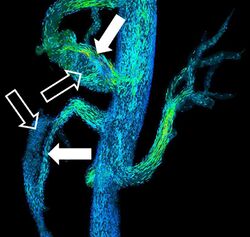Magnetic resonance velocimetry
 From HandWiki - Reading time: 3 min
From HandWiki - Reading time: 3 min

Magnetic resonance velocimetry (MRV) is an experimental method to obtain velocity fields in fluid mechanics. MRV is based on the phenomenon of nuclear magnetic resonance and adapts a medical magnetic resonance imaging system for the analysis of technical flows. The velocities are usually obtained by phase contrast magnetic resonance imaging techniques. This means velocities are calculated from phase differences in the image data that has been produced using special gradient techniques. MRV can be applied using common medical MRI scanners.[2] The term magnetic resonance velocimetry became current due to the increasing use of MR technology for the measurement of technical flows in engineering.[3]
Applications
In engineering MRV can be applied to the following areas:
- Analysis of technical flows in complex geometries (separation, recirculation zones)
- Validation of numerical simulations in computational fluid dynamics using 3D velocity fields
- Iterative design of complex inner flow channels (combined with rapid prototyping)
- Measurement of concentration distributions in mixing processes
- Analysis of flow through porous media
- Interaction of immiscible fluids
Advantages and limitations
In contrast to other non-invasive velocimetry methods such as PIV or LDA, no optical access is required. Besides, no particles have to be added to the fluid. Thus, MRV enables to analyze the complete flow field in complex geometries and components.[4] Based on the fact that common MR scanners are designed to detect the nuclear magnetic resonance of hydrogen protons, the tested applications are limited to water flows. Common fluid mechanical scaling concepts compensate this limitation. To achieve the spatial resolution, single data acquisition steps have to be repeated a great number of times with slight variations. Thus, MRV technology is limited to steady or periodical flows.[5]
See also
- Flow measurement
- Particle image velocimetry
- Laser Doppler anemometry
References
- ↑ Hartung, Michael P; Grist, Thomas M; François, Christopher J (2011). "Magnetic resonance angiography: current status and future directions". Journal of Cardiovascular Magnetic Resonance 13 (1): 19. doi:10.1186/1532-429X-13-19. ISSN 1532-429X. PMID 21388544. (CC-BY-2.0)
- ↑ Ku, D.N.; Biancheri, C.L.; Pettigrew, R.I.; Peifer, J.W.; Markou, C.P.; Engels, H. (1990). "Evaluation of magnetic resonance velocimetry for steady flow". Journal of Biomechanical Engineering 112 (4): 464–472. doi:10.1115/1.2891212. PMID 2273875.
- ↑ Elkins, C.J.; Markl, M.; Pelc, N.; Eaton, J.K. (2003). "4D Magnetic resonance velocimetry for mean velocity measurements in complex turbulent flows". Experiments in Fluids 34 (4): 494–503. doi:10.1007/s00348-003-0587-z. Bibcode: 2003ExFl...34..494E.
- ↑ Elkins, C.; Alley, M.T. (2007). "Magnetic resonance velocimetry: applications of magnetic resonance imaging in the measurement of fluid motion". Experiments in Fluids 43 (6): 823–858. doi:10.1007/s00348-007-0383-2. Bibcode: 2007ExFl...43..823E.
- ↑ Fukushima, E. (1999). "Nuclear magnetic resonance as a tool to study flow". Annual Review of Fluid Mechanics 31: 95–123. doi:10.1146/annurev.fluid.31.1.95. Bibcode: 1999AnRFM..31...95F.
Further reading
- Elkins, C.J.; Markl, M.; Pelc, N.; Eaton, J.K. (2003). "4D Magnetic resonance velocimetry for mean velocity measurements in complex turbulent flows". Experiments in Fluids 34 (4): 494–503. doi:10.1007/s00348-003-0587-z. Bibcode: 2003ExFl...34..494E.
- Elkins, C.; Alley, M.T. (2007). "Magnetic resonance velocimetry: applications of magnetic resonance imaging in the measurement of fluid motion". Experiments in Fluids 43 (6): 823–858. doi:10.1007/s00348-007-0383-2. Bibcode: 2007ExFl...43..823E.
- Fukushima, E. (1999). "Nuclear magnetic resonance as a tool to study flow". Annual Review of Fluid Mechanics 31: 95–123. doi:10.1146/annurev.fluid.31.1.95. Bibcode: 1999AnRFM..31...95F.
- Ku, D.N.; Biancheri, C.L.; Pettigrew, R.I.; Peifer, J.W.; Markou, C.P.; Engels, H. (1990). "Evaluation of magnetic resonance velocimetry for steady flow". Journal of Biomechanical Engineering 112 (4): 464–472. doi:10.1115/1.2891212. PMID 2273875.
External links
- Professor John Eaton's profile (Stanford University)
- Group “Magnetic Resonance Imaging for Mechanical Engineering (Technische Universität Darmstadt, Germany)
- "Velocity and thermometry in technical flows" (Medical Physics Group, Universitätsklinikum Freiburg, Germany)
- "Measurement of cytoplasmic streaming in single plant cells by magnetic resonance velocimetry"
- "State of the art MRI with accurate diagnosis and the best patient experience at Queen Square"
 |
 KSF
KSF